![]()
![]()
![]()
Use LEFT and RIGHT arrow keys to navigate between flashcards;
Use UP and DOWN arrow keys to flip the card;
H to show hint;
A reads text to speech;
110 Cards in this Set
- Front
- Back
|
Parts of an animal cell.
|
Nucleus
Cytoplasm Cell Membrane Ribosomes Mitochondria |
|
|
Parts of a plant cell.
|
Nucleus
Cytoplasm Cell Membrane Cell Wall Ribosomes Mitochondria And most of the time: A Permanent Vacuole Chlorophyll and Chloroplast |
|
|
Nucleus, in biology.
|
Is a collection of DNA, on genes on chromosome. It controls all activity in a cell. Some cells like red blood cells don't have it.
|
|
|
Cytoplasm
|
Cytoplasm is a gel where most of life's chemical reactions take place.
|
|
|
Cell Membrane
|
A thin layer around the cell that controls the substance allowed in and out of said cell.
|
|
|
Cell Wall
|
A Plant cell only feature, that gives the cells structure and strength.
|
|
|
Ribosomes
|
Where protein synthesise happens. All proteins a cell needs are made here.
|
|
|
Mitochondria
|
A structure in cytoplasm which uses oxygen and produces most of a cells energy, during respiration.
|
|
|
Chlorophyll and Chloroplast
|
Chlorophyll is a green substance, which green Chloroplast inside. It is mostly found in green plant leaves, as it is used in the process of photosynthesising.
|
|
|
Vacuole
|
A plant cell only feature, that contains cell sap. It is important as it gives the plant structure.
|
|
|
Plant Cell Diagram
|
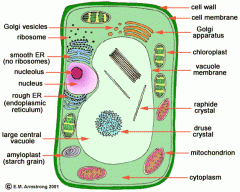
Basic Plant diagram, with extras.
|
|
|
Animal Cell Diagram
|
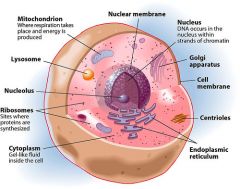
Basic Plant Diagram, with extras.
|
|
|
Size of most bacteria?
|
1 micrometer.
|
|
|
Bacteria are ...
|
Bacteria are single-celled organisms which are often many hundreds of times smaller than normal cells.
|
|
|
Bacteria Parts?
|
Cytoplasm
Cell Membrane Slime Capsule Cell Wall Plasmids Flagella Genetic Material (DNA) |
|
|
Plasmids are...
|
Small circular collections of DNA found in Bacteria.
|
|
|
Flagella are ...
|
Strands of protein which many types of bacteria have hanging out.
|
|
|
Yeast is ...
|
a type of microogranism, with only cell membranes, cytoplasm, cell wall and a nucleus.
They are normally 3-4 micrometers and asexually reproduce. |
|
|
The waste products for yeast when respiring anaerobically?
|
Ethanol and Carbon Dioxide
|
|
|
The Waste products produced when yeast respires aerobically?
|
Water and Carbon Dioxide.
|
|
|
Specialised Cells
|
Cells which have become function specific through Differentation from stem cells.
|
|
|
Fat cells
|
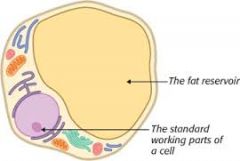
Regular animal cells with little mitochondria and cytoplasm, with a fat store.
Can expand to thousands of times its original size. |
|
|
Human Eye Cone Cells.
|
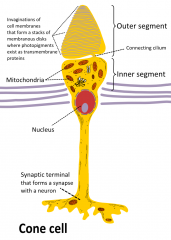
Special pigment to help see at the top of the cell.
A heavily mitochondria filled centre and a special synapse at the deepest part of the cell, that connects to the optical nerve. |
|
|
Plant: Root hair cells
|
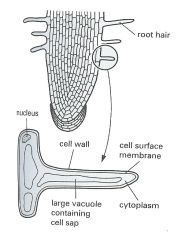
Large vacuole and a large surface area to take in water more easily.
|
|
|
Sperm Cell
|
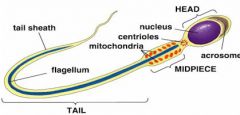
A large nucleus to pass down genetic info.
A long tail to move easily in the womb, coupled with a middle section full of mitochondria to give energy for movement. Arcosome at the tip to break down the females egg on contact. |
|
|
Diffusion is...
|
... The process of spreading out a gas or liquid in a substance.
|
|
|
Diffusion goes from ____ concentration areas to ____ concentration areas.
|
Diffusion goes from high concentration areas to low concentration areas.
|
|
|
A big difference in concentration means ...
|
... fast diffusion.
|
|
|
Net movement =
|
particles in - particles out.
|
|
|
The concentration gradient is ...
|
... the difference in concentration between two areas.
|
|
|
High temperature means ...
|
... a high rate of diffusion.
|
|
|
Organism also diffuse.
Name the most common adaptation to make diffusion faster. |
Increasing surface area of the membrane diffused through, through folds.
|
|
|
Name the five basic levels of organisation of body parts.
|
Cells <- Tissue <- Organ <- Organ System <- The Body
|
|
|
A Tissue is ...
|
... A collection of identical or very similar cells. An example is the skin.
|
|
|
Name three examples of animal tissues and two of plant tissues.
|
Animal:
Skin (Epithilical Tissue) Muscular Tissue Glandular Tissue Plant: Xylem Phloem |
|
|
Organs are ...
|
... a collection of tissues.
An example is the stomach which digests food. |
|
|
An organ system is ...
|
... A collect of organs that carry out a major function, such as the Cardiovascular system.
|
|
|
Photosynthesis equation
|
Carbon Dioxide + Water ->(with light) Glucose + Oxygen
|
|
|
Limiting factors of photosynthesis (3)
|
Light intensitry, Carbon Dioxide levels and Temperature.
|
|
|
Plants use glucose straight away for ____ and store it in ____ for later use, if there is an excess.
|
Respiration; starch
|
|
|
Plants make amino acids by...?
|
... reacting glucose with mineral ions, like nitrate ions, found in the soil.
|
|
|
Variables affecting living organisms (8)
|
Temperature
Nutrients Light Water Oxygen Carbon dioxide Competition Pollution |
|
|
Quadrants are ...
|
... A random sampling method that uses area size of a small section.
|
|
|
Enzymes are ...
|
... biological catalyst made of proteins. They use a key and Lock mechanisms to speed up reactions in the body.
|
|
|
Enzymes do three things. Name them.
|
Building bigger proteins/structures from small ones.
Breaking up big proteins/structure into small ones. Changing one molecule into another one. |
|
|
Enzymes do not ...
|
... change a reaction, they just speed it up.
|
|
|
How does an enzyme work?
|

The substrate, or reactant, fits into the active site of the enzyme, in a sort of lock and key method.
Once the substrate are in place the enzyme binds or unbinds them. |
|
|
If the temperature is too ____, then the enzyme(or any type of protein) becomes ____.
|
High; Denatured.
|
|
|
The optimal temperature for most enzymes is ...
|
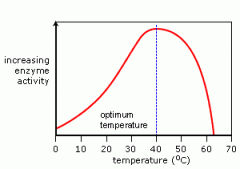
... 40 degrees Celsius; any more and the enzymes denature; any less and they do not work to their full potential.
|
|
|
At high temperatures the enzymes denature causing it to ...
|
... breakdown and unravel.
|
|
|
Enzymes are needed or ...
|
... reactions can;t happen fast enough to keep you alive.
|
|
|
Carbohydrase
|
Enzyme that breaks down carbohydrates. Amylase is an example.
|
|
|
Amylase
|
Breaks down starch into glucose. It is produced in the small intestine, salivary glands and pancreas.
|
|
|
Protease
|
Breakdown proteins into amino acids. Produced by the pancreas, stomach and small intestine.
|
|
|
Lipase
|
Breaks down lipids (fat) into fatty acids and glycerol. Made in the pancreas and small intestines.
|
|
|
What is broken down in the pancreas?
|
Absolutely nothing. The pancreas only creates enzymes that are used in other areas, like the stomach and small intestine.
|
|
|
Broken down substances are then ...
|
... passed through into the blood stream, mostly through capillaries.
|
|
|
What pH condition do enzymes work best in?
|
It is dependent on the enzyme.
|
|
|
How does the gut regulate the pH levels in it to keep the various enzymes working at optimal levels?
|
Your stomach creates acid, for the stomach protease to work well. There is mucus to avoid the lining being digested.
Moving into the small intestine, the acid is neutralised by coming into contact with bile, an alkaline. More bile is added until it becomes an alkaline. Enzymes in the small intestine work best in alkaline. |
|
|
Bile is made in ...
|
... the liver and is greenish-yellow in colour.
|
|
|
Bile is stored in the ...
|
... gall bladder, until needed.
|
|
|
Enzymes work best with lots of surface area.
This is not a problem with ___ and ____, but is a problem with ____. What does Bile do to help this. |
Protein; Carbohydrates; Lipids;
Bile emulsifies the fats in water to allow it to be easily processed. |
|
|
Biological detergents use enzymes. Why are they good?
|
They need a lower temperature to work in at a more efficient level. This means clothes are cleaner and less electricity and thus money are needs.
|
|
|
Protease is used in industry to ...
|
... create baby food. add protease to break down the long proteins - becomes predigested which is easier for babies to eat.
|
|
|
Carbohydrase are used to ____ in industry.
|
Create cheap sugar from vegetable starch, like corn,
|
|
|
Isomerase does what exactly?
|
Changes glucose into fructose, which taste sweeter, in the same volume. It is mostly irrelevant, but is used in industry to reduce calories slightly, make food seem, "healthier."
|
|
|
Aerobic Respiration equation
|
Glucose + Oxygen -> Carbon Dioxide + Water (+ energy)
|
|
|
Anaerobic Respiration formula.
|
Glucose -> Lactic Acid + a little Energy
Note to self: Double check this. |
|
|
Anaerobic respiration is used ...
|
... when there is no oxygen.
|
|
|
Glycogen is what, stored in where?
|
It is an insoluble form of glucose and is stored in the muscles.
|
|
|
Cardiac Output
|
Beats per minute * Stroke volume.
It is the blood pumped per minute. |
|
|
Exercise causes you to ...
|
Strengthen muscles
Causes Vasodilation to allow more blood, and thus oxygen to the muscles. Cause you to breath more rapidly and deeper, to get more oxygen for working muscles and remove more waste product. |
|
|
A build up of lactic acids causes ...
|
... muscle fatigue (or cramping)
|
|
|
Oxygen Debt
|
Is breathing heavily to give back the stored oxygen used in anaerobic situations.
Lactic acid+oxygen->water+carbon dioxide |
|
|
A Gene
|
A section of DNA(Genetic info)
|
|
|
Alleles
|
Different variants of the same gene.
A Capital is a dominant trait; A lower case letter is Recessive trait. |
|
|
Chromosomes
|
A collection of hundreds or even thousands of genes. Most humans have 46, or two pairs 23.
You can have 45 or 47 but this causes either down syndrome or lack of a sex organ (hermaphrodites,) respectively. |
|
|
Gamates (sex cells) have how many chromosomes?
|
Half as many as usual. One from each pair.
|
|
|
Mitosis
|
Creating a identical cell.
|
|
|
The process of Mitosis.
|
1. Chromosomes, become fat and short.
2. They go to the middle of the nucleus. 3. They start to create an identical copy of themselves. 4. They separate and go to opposite ends of the nucleus. 5. They split the cell in half. 6. They become thin again. |
|
|
Differentation
|
Most cells in the human body, become specialised in very early on as a foetus, even if not all the cells have been switched on ( gametes.)
|
|
|
Stem Cell
|
The basic cell. Animals lose most of them early on, but store some in the bone marrow.
Plants always have a steady supply. |
|
|
Meiosis
|
The formation of gametes.
|
|
|
The process of Meiosis
|
Follows the steps for mitosis. At the end of mitosis, the cells immediately split again, forming cells with only half of the genetic data.
|
|
|
Issues with stem cells
|
Many people debate that it is unethical because it comes from a fetus that cannot consent.
It has potential to cause cancer, according to some studies on mice. |
|
|
XX Sex Chromosomes mean ...
|
That you are a girl.
|
|
|
XY Sex Chromosomes mean ...
|
That you are a male.
|
|
|
Dominant Alleles
|
Are indicated by a Capital Letter. One single Dominant Alleles in a pair means that, it takes over for example A single F Allele means that the person will have Cystic Fibrosis.
Dominant Alleles can't be carried. |
|
|
Recessive Alleles
|
Represented by a lower case letter. If there are no Dominant Alleles, the effect of this allele takes place.
|
|
|
Homozygous
|
A Characteristic with two identical alleles. E.g. DD or dd
|
|
|
Heteroxygous
|
A characteristic with two non-identical alleles. E.g. Dd
|
|
|
Genotype
|
Represents the genetic make up of a characteristic, in an individual.
|
|
|
Phenotype
|
The physical cause of a particular genotype. E.g. Dimples
|
|
|
A Fossil is ...
|
... A rock of some sort, that contains some sort of imprint or details of a body part.
|
|
|
Fossils are formed by ...
|
... removing the potential for bacteria to decompose the thing to be fossilised.
Examples of this include, freezing, being stored in peat, and covered very quickly and at a high pressure. |
|
|
Extinctions are caused bY(6)
|
Changes to the environment which the animal is not adapted for
New predators New diseases More successful competition Catastrophic event i.e volcanoe Cyclical nature of speciation |
|
|
Stomach - main function, enzyme(s) produced and tissue's functions
|
Is where digestion occurs: has muscular tissue to chum the contents; glandular tissue to produce protease and hydrochloric acid, and epithelial tissue to cover the inside and the outside lining to protect it from being damaged by the acid.
|
|
|
Humans can use energy released during respiration for: (4)
|
Building larger molecules out of smaller ones
Muscles contracting Maintaining a steady body temperature Making amino acids out of nitrate ions and sugar |
|
|
During exercise the heart rate and depth of breathing.... Why?
|
Increases so that more blood supplying oxygen and energy can be transported to the cells - increasing the rate of the removal of carbon dioxide.
|
|
|
Examples of proteins
|
Antibodies
Biological catalysts - enzymes Hormones Muscle |
|
|
Disadvantages of enzymes (2)
|
Cost a lot to produce (through fermentation)
Can easily denature if temperatures go too high |
|
|
Mendel's experiment and what this meant
|
He bred two purebred peas with different colours/heights which resulted in the offspring having dominant phenotypes. By then breeding two of these heterozygous peas he created a variety of phenotypes - proving that genes did not blend and that two pieces of DNA are taken to account.
|
|
|
Why was Mendel's work not appreciated until many years after his death?
|
His work preceded the discovery of chromosones
|
|
|
Stem cells - what are they, how can they be found and what are its capabilities?
|
Unspecialised and undifferentiated bunch of cells which form about 5 days after fertilisation from human embryos which have the potential to become any cell. They can be also be taken from adult bone marrow
|
|
|
Advantages of stem cells
|
Could potentially help Parkinson's and paralysis.
|
|
|
Polydactyly
|
Having extra fingers or toes which is caused by a dominant allele
|
|
|
Cystic fibrosis
|
Disorder of cell membranes which is caused by a recessive allele
|
|
|
Embryo screening(A+D)
|
A way of checking embryos to see if they carry the alleles for particular diseases
Could eradicate diseases and so the person would have a better quality of life,It would save costs on future drugs.Could lead to choosing a specific gender and carriers could be discarded (killed). |
|
|
How are fossils formed? (4)
|
From hard parts such as teeth which do not decay easily
When one or more of the conditions needed for decay is absent When parts of the organism are replaced by other materials as they decay Preserved traces such as footprints, burrows and rootlets. |
|
|
New species arise by (4)
|
1.Isolation-Two populations of a species become separated 2.Genetic variation-Wide range of alleles that control their characteristics 3.Natural selection-The specific alleles which control characteristics to help them survive are selected and so can be passed on 4.Speciation-When populations become so different that interbreeding is no longer possible
|

